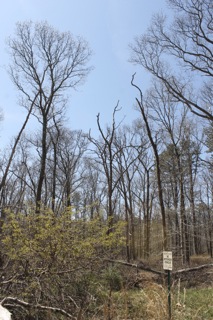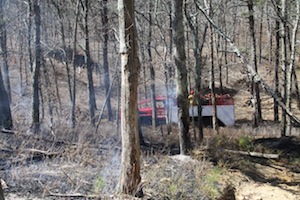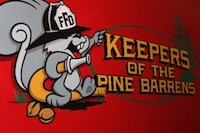Hundreds of homes tucked into thousands of acres of preserved pine barrens in the Flanders Fire District are at high risk of being consumed by wildfire, and Flanders Fire Chief Todd Ryan says, as things stand, there’s not much firefighters will be able to do to save them.
The government entities that own the preserved lands must undertake the maintenance needed to provide firefighters safe access the woodlands to fight wildfires — and to reduce the extraordinarily high volume of wildfire “fuel” within those woods, according to the veteran fire chief.
But Ryan said when he talks to government officials about taking action, they all say the same thing: “There’s no money.”
“I’m tired of all the bulls–t and I don’t want to hear it any more,” Ryan said Saturday morning during a tour of the perimeter of the preserved lands.
The state pine barrens commission, whose staff members told Ryan there’s no money to remove dead oak trees scattered throughout thousands of acres of the pine barrens following a massive die-off in the mid-2000s — action Ryan says is urgently needed — voted in December to award a $697,000 contract to a Medford consulting firm for a survey, assessment and maintenance services over the next five years.
“You don’t need another damned survey,” Ryan said this morning, when told of the contract signed with Land Use Ecological Services earlier this year. “It’s already been surveyed and studied and studied. We know what needs to be done,” he said.
“It’s not complicated. Get some bulldozers and chain saws and take out the dead trees so we can get into the woods if there’s a fire,” he said, exasperation in his voice.
“Clean up the fire breaks and trails that are all overgrown,” he said. “I’ve lived here 30 years. The trails used to be much wider. Now, even where they’re not blocked by falled trees, they’re so overgrown they are barely passable.”
There are more than 11,000 acres of preserved pine barrens adjoining hundreds of homes south of Flanders Road. The woodlands haven’t burned — a natural, cyclical occurrence in the fire-dependent pine barrens ecosystem — since the 1960s, according to Ryan.
“It’s bound to happen, and when it does, it’s going to be a disaster,” Ryan said.
“The fire in Manorville? That was nothing. This has the potential to be far worse even than 1995,” Ryan said, referring to the wildfire that scorched more than 7,000 acres of pine barrens. It was dubbed the Sunrise fire because its wall of flames leapt over the expanse of the Sunrise Highway.
 There is an enormous amount of fuel for what Ryan regards as an inevitable wildfire in his district. The source of the fuel isn’t just “normal brush” or a few dead trees, he said.
There is an enormous amount of fuel for what Ryan regards as an inevitable wildfire in his district. The source of the fuel isn’t just “normal brush” or a few dead trees, he said.
The entire forest is littered with fallen oak trees and limbs. In some places, the downed tall trees, scattered every which way, resemble a child’s game of pick-up sticks.
“There’s no way we could get through this to fight a fire and protect these nearby homes,” Ryan said.
The massive die-off of oak trees and other hardwoods in the pine barrens within the Flanders district occurred in the middle of the last decade. It was the result of a combination of drought that stressed the trees, insect infestations and fungal disease following an unusually wet period.
“It wiped out the oaks,” Ryan said. “You can easily see it. There’s all dead trees, all through here. It’s not just pockets here and there. It’s all through the whole forest,” he said, driving down Pleasure Drive in Flanders and into a subdivision off the long, narrow road that cuts through the forest, jutting south from Flanders Road almost to the Sunrise.
The die-off was so severe it was surveyed and mapped by the state Department of Environmental Conservation in 2008. The forest health unit in the DEC lands and forests division mapped 14,166 acres of “hardwood mortality.” A huge block of “hardwood mortality” on the DEC map is within the Flanders Fire District.
 On Saturday, Ryan pulled his truck into a subdivision off Pleasure Drive for a closer look at an area where a “small wildfire” burned about 100 preserved acres a few days before the big Manorville fire last April. Flanders firefighters were able to contain it and put it out before it threatened nearby homes.
On Saturday, Ryan pulled his truck into a subdivision off Pleasure Drive for a closer look at an area where a “small wildfire” burned about 100 preserved acres a few days before the big Manorville fire last April. Flanders firefighters were able to contain it and put it out before it threatened nearby homes.
But the condition of the forest floor has worsened significantly since then, Ryan said. Hurricane Sandy and this winter’s nor’easters brought down a huge number of dead oaks that last spring were still standing, he said.
“Dead trees still standing are not a good thing either,” Ryan said. “When they burn, their tops explode,” he said.
The large number of dead trees in the preserved lands inspired the Flanders Fire Department to retrofit its brush trucks with steel cages about 18 months ago, in the hopes of protecting firefighters from falling trees and limbs.
The fallen dead oaks are also blocking the few fire trails that exist.
“We need more trails, but even the few we have are impassable,” Ryan said.
The veteran firefighter — he’s on his second rotation as a chief in his 24 years in the department — says he’s met several times with staff members of the government commission in charge of the pine barrens.
 Surveying the woodlands Saturday, pointing out the scattered fallen oaks, Ryan repeatedly shook his head in disgust at what he sees as the inability of government to carry out a simple task that will save people’s homes and lives.
Surveying the woodlands Saturday, pointing out the scattered fallen oaks, Ryan repeatedly shook his head in disgust at what he sees as the inability of government to carry out a simple task that will save people’s homes and lives.
He’s taken members of the state pine barrens commission staff on the same tour, he said.
John Pavacic, pine barrens commissin executive director, acknowledged taking a ride through the area with the fire chief.
Pavacic said the commission, which does not own any of the preserved lands, has “been in contact” with both the Suffolk County parks department and the state DEC, which manage the thousands of acres of preserved lands owned by the county and the state within the Flanders Fire District.
A spokesperson for the DEC said in an email last month the agency’s “efforts focus on performing prescribed burns to remove the amount of flammable debris and vegetation that could catch fire. See April 15 story, “Firefighters concerned preserved Pine Barrens not maintained well to prevent spread of wildfires.”
“In addition, this spring DEC purchased a forestry cutter that will be used to rapidly cut brush and woody debris to help with fire prevention on state lands by re-establishing and maintaining firebreaks.”
A spokesperson for the county said the county “works with fire departments that get in touch county land management officials about their concerns.”
Neither spokesperson could provide any information specific to the Flanders pine barrens.
Pavacic said the contract with Land Use Ecological Services, though not specifically aimed at the pine barrens within the Flanders district, will help.
Pavacic said the contract has four major components: an ecological inventory management and assessment; prescribed fires, which will cost about $200,000; grassland management; and invasive species management. The contract is for a period of five years and covers the entire central pine barrens region, he said.
There will be some removal of downed trees in conjunction with the prescribed fires, Pavacic said.
But the oak die-off is part of the natural ecological cycle of the forest and the dead trees have benefits, Pavacic said. They provide habitat for different types of species — cavity nesters such as woodpeckers and owls. As they decay they are also food sources for other species, he said.
“Another study, hundreds of thousands of dollars… that isn’t going to do a damned thing,” the fire chief said. “It’s just another example of more government waste as far as I’m concerned. But I run a small fire department,” Ryan said. “Who’s going to listen to me?”
“If — when — a wildfire burns these woods and we can’t get in there to stop it, maybe then they’ll pay attention. Or maybe they’ll just do another study,” he said. “Unbelievable.”
RiverheadLOCAL photos and video by Denise Civiletti
Click thumbnails to enlarge images
{gallery}2013/slideshows/2013_0502_pine_barrens_flanders{/gallery}
{loadposition tab1}
The survival of local journalism depends on your support.
We are a small family-owned operation. You rely on us to stay informed, and we depend on you to make our work possible. Just a few dollars can help us continue to bring this important service to our community.
Support RiverheadLOCAL today.































